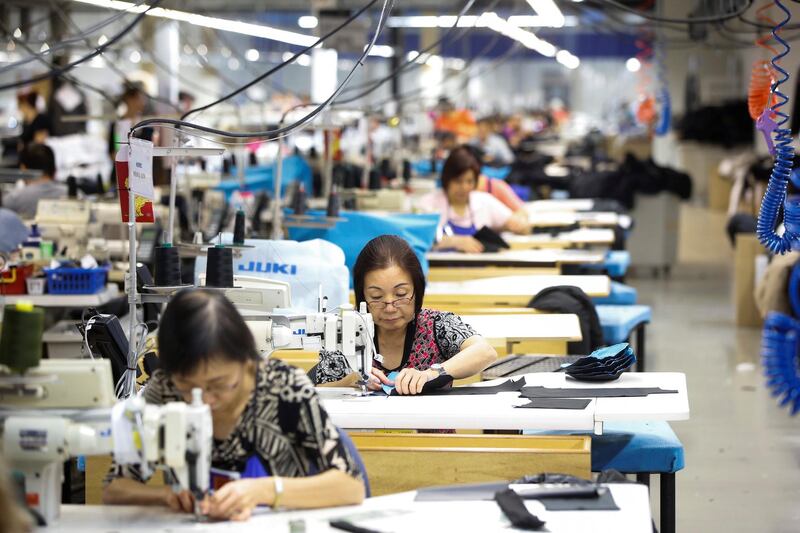There are two textile-obsessed columnists at Bloomberg View. One, Adam Minter, based in Kuala Lumpur, is writing a book about used goods, including the global trade in secondhand clothes. The other, Virginia Posterl, based in Los Angeles, is also writing a book – about textiles, technology and trade. Here's how they see global trends playing out in the coming years.
What has changed over the past few years in the textiles industry?
Adam Minter: Years ago, I visited a Chinese factory where several hundred workers spent long days using sandpaper and razor blades to distress jeans manufactured for a US apparel brand. Levi Strauss is now replacing that hand labour in its production of distressed jeans with lasers and automation.
If automation is poised to shift mass production to high wage countries, what role will developing countries play in textiles and apparel in coming decades?
Virginia Postrel: Textile and apparel making is no longer going to provide the well-established path for a poor country to industrialise. That’s one reason for economist Dani Rodrik’s fears of “premature deindustrialisation” ,which he describes as “many [if not most] developing nations,” particularly in Latin America and Africa, “becoming service economies without having had a proper experience of industrialisation”.
Is fashion destined to become a hyper-localised industry, much like it was before the Industrial Revolution?
VP: In the near term, the bigger challenge for apparel makers, wherever they are, is that people in developed countries, particularly the US, seem to be losing interest in buying new clothes.
Adam, Is it something you’re seeing in your book research on the used clothing trade?
AM: Not really. In the developing world, emerging market consumers are buying more clothes than ever - especially used clothes. However, this demand isn't just about the cheap price of used clothing. It's about quality. In Ghana, where I've spent time over the past two years, imported secondhand clothes are often more expensive than new clothes. If you wander through a used clothing market in Ghana, you'll find very little in the way of fast-fashion brands. Used clothing exporters look for durable used garments, and they work hard to keep low-quality fast-fashion out of their shipping containers.
VP: The “death of clothing” is definitely a first-world phenomenon and quite possibly a North American one. Aside from sheer satiation because our closets are full and we’d rather spend the money on food or travel, I suspect that the emphasis on casual comfort has simply made new clothes boring. They no longer offer something transformative or special.
_______________
Read more:
Exclusive: Emboldened retailers to seek lower rents in 2018, says Nakheel CEO
UK high streets feel pinch as perfect storm gathers for retailers
_______________
AM: American consumers pay lip-service to the idea that fast-fashion purchases fall apart after a wash or two (and then head back to H&M for more). For emerging market consumers, fast-fashion's lack of durability drives purchasing decisions. Apparel manufacturers could potentially accelerate the opening up of a massive market.
VP: The cost of equipment is going down, so it could eventually pose a challenge to secondhand clothes in emerging economies, especially as established manufacturers in places like Bangladesh and China look for markets nearer to home. It might also reduce the supply of secondhand clothes by offering consumers in affluent countries garments worth hanging on to longer.
AM: From a secondhand-market standpoint, the China question is the crucial one. China stopped accepting imports of secondhand clothing in the 1990s, in part to encourage domestic consumption of the large volume of apparel already being manufactured there for export. Whether or not the ban made any difference is debatable - I think the key factor was rising incomes - but what's not debatable is the volume of new clothing China now consumes. By the end of the decade, it will surpass the United States to become the world's largest apparel market - and much of that apparel will be fast-fashion. By one recent estimate, the number of times a garment is worn in China has declined by 70 per cent between 2000 and 2015.
China has become one of the world's top exporters of secondhand clothes. In Africa, it's not at all unusual to see secondhand clothing markets stocked with T-shirts covered in Chinese characters. What Chinese manufacturers produce for China's domestic market tends to be of poorer quality than what they produce for export markets.
VP: China’s advantage lies less in low wages than in state-of-the-art equipment and expertise. And, of course, China also has a vast domestic market, as well as potential customers in the region, where the quick-turnaround advantages of more automation would be relevant.
AM: Yet there’s growing volumes of Chinese apparel waste, both at home and abroad. Many international clothing traders won't touch Chinese clothes.
I think the development of online, cross-border trade can reduce this waste at the high end of the market. Good quality garments will be traded and used between multiple users. But that's a small percentage of the whole.
VP: Maybe that will involve tapping local aesthetics for an international market - producing quality garments that can sell for higher prices in developed countries while still appealing to the home market. California casual could use some African competition.
AM: The big question is what happens to unbranded, lower-quality goods. In recent years there's been money and attention lavished on developing technology that can transform old textiles into quality new fibres. If that kind of technology can be scaled, it would lower the cost of clothing while reducing guilt and wastage. From a technological standpoint, I'm an optimist when it comes to the future of secondhand and new clothing.





